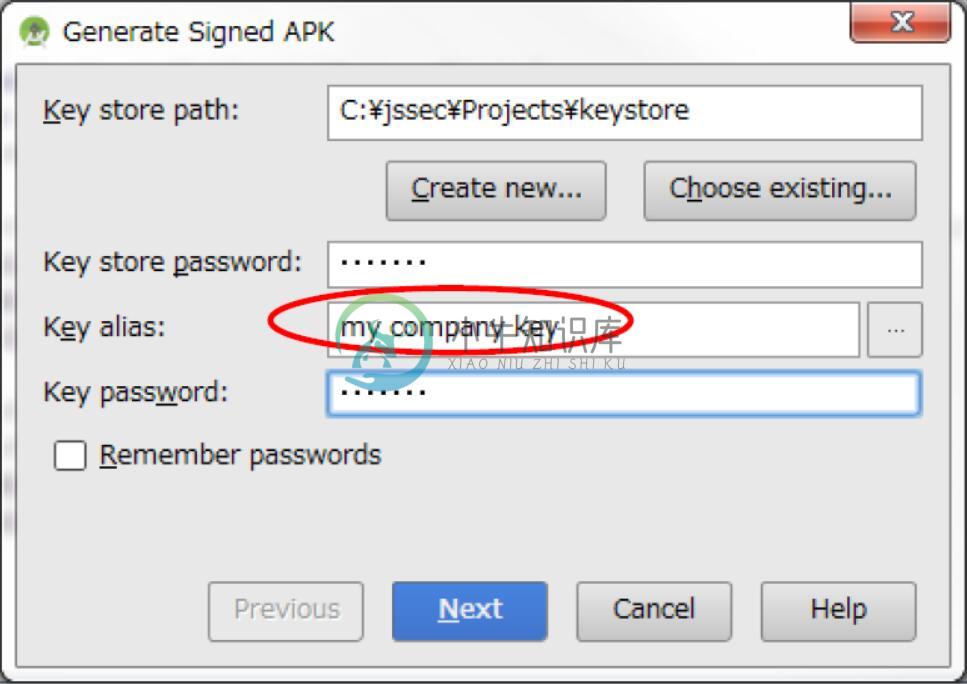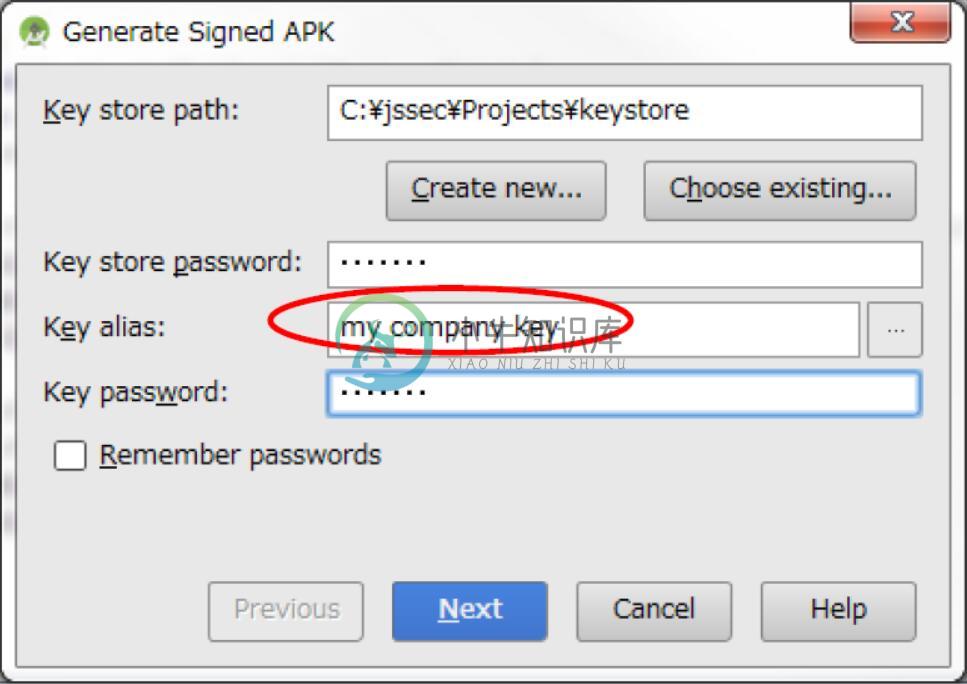4.4.1.4 创建/使用内部服务
优质
小牛编辑
137浏览
2023-12-01
4.4.1.4 创建/使用内部服务
内部服务是除了内部应用以外的应用禁止使用的服务。 它们用于内部开发的应用,以便安全地共享信息和功能。 以下是使用Messenger绑定类型服务的示例。
要点(创建服务):
定义内部签名权限。
需要内部签名权限。
不要定义意图过滤器,并将导出属性显式设置为
true。确认内部签名权限是由内部应用定义的。
尽管意图是从内部应用发送的,但要小心并安全地处理接收到的意图。
由于请求应用是内部的,因此可以返回敏感信息。
导出 APK 时,请使用与请求应用相同的开发人员密钥对 APK 进行签名。
AndroidManifest.xml
<?xml version="1.0" encoding="utf-8"?>
<manifest xmlns:android="http://schemas.android.com/apk/res/android"
package="org.jssec.android.service.inhouseservice.messenger" >
<!-- *** POINT 1 *** Define an in-house signature permission -->
<permission
android:name="org.jssec.android.service.inhouseservice.messenger.MY_PERMISSION"
android:protectionLevel="signature" />
<application
android:icon="@drawable/ic_launcher"
android:label="@string/app_name"
android:allowBackup="false" >
<!-- Service using Messenger -->
<!-- *** POINT 2 *** Require the in-house signature permission -->
<!-- *** POINT 3 *** Do not define the intent filter and explicitly set the exported attribute to true. -->
<service
android:name="org.jssec.android.service.inhouseservice.messenger.InhouseMessengerService"
android:exported="true"
android:permission="org.jssec.android.service.inhouseservice.messenger.MY_PERMISSION" />
</application>
</manifest>
InhouseMessengerService.java
package org.jssec.android.service.inhouseservice.messenger;
import org.jssec.android.shared.SigPerm;
import org.jssec.android.shared.Utils;
import java.lang.reflect.Array;
import java.util.ArrayList;
import java.util.Iterator;
import android.app.Service;
import android.content.Context;
import android.content.Intent;
import android.os.Bundle;
import android.os.Handler;
import android.os.IBinder;
import android.os.Message;
import android.os.Messenger;
import android.os.RemoteException;
import android.widget.Toast;
public class InhouseMessengerService extends Service{
// In-house signature permission
private static final String MY_PERMISSION = "org.jssec.android.service.inhouseservice.messenger.MY_PERMISSION";
// In-house certificate hash value
private static String sMyCertHash = null;
private static String myCertHash(Context context) {
if (sMyCertHash == null) {
if (Utils.isDebuggable(context)) {
// Certificate hash value of debug.keystore "androiddebugkey"
sMyCertHash = "0EFB7236 328348A9 89718BAD DF57F544 D5CCB4AE B9DB34BC 1E29DD26 F77C8255";
} else {
// Certificate hash value of keystore "my company key"
sMyCertHash = "D397D343 A5CBC10F 4EDDEB7C A10062DE 5690984F 1FB9E88B D7B3A7C2 42E142CA";
}
}
return sMyCertHash;
}
// Manage clients(destinations of sending data) in a list
private ArrayList<Messenger> mClients = new ArrayList<Messenger>();
// Messenger used when service receive data from client
private final Messenger mMessenger = new Messenger(new ServiceSideHandler(mClients));
// Handler which handles message received from client
private static class ServiceSideHandler extends Handler{
private ArrayList<Messenger> mClients;
public ServiceSideHandler(ArrayList<Messenger> clients){
mClients = clients;
}
@Override
public void handleMessage(Message msg){
switch(msg.what){
case CommonValue.MSG_REGISTER_CLIENT:
// Add messenger received from client
mClients.add(msg.replyTo);
break;
case CommonValue.MSG_UNREGISTER_CLIENT:
mClients.remove(msg.replyTo);
break;
case CommonValue.MSG_SET_VALUE:
// Send data to client
sendMessageToClients(mClients);
break;
default:
super.handleMessage(msg);
break;
}
}
}
/**
* Send data to client
*/
private static void sendMessageToClients(ArrayList<Messenger> mClients){
// *** POINT 6 *** Sensitive information can be returned since the requesting application is inhouse.
String sendValue = "Sensitive information (from Service)";
// Send data to the registered client one by one.
// Use iterator to send all clients even though clients are removed in the loop process.
Iterator<Messenger> ite = mClients.iterator();
while(ite.hasNext()){
try {
Message sendMsg = Message.obtain(null, CommonValue.MSG_SET_VALUE, null);
Bundle data = new Bundle();
data.putString("key", sendValue);
sendMsg.setData(data);
Messenger next = ite.next();
next.send(sendMsg);
} catch (RemoteException e) {
// If client does not exits, remove it from a list.
ite.remove();
}
}
}
public IBinder onBind(Intent intent) {
// *** POINT 4 *** Verify that the in-house signature permission is defined by an in-house application.
if (!SigPerm.test(this, MY_PERMISSION, myCertHash(this))) {
Toast.makeText(this, "In-house defined signature permission is not defined by in-house application.", Toast.LENGTH_LONG).show();
return null;
}
// *** POINT 5 *** Handle the received intent carefully and securely,
// even though the intent was sent from an in-house application.
// Omitted, since this is a sample. Please refer to "3.2 Handling Input Data Carefully and Securely."
String param = intent.getStringExtra("PARAM");
Toast.makeText(this, String.format("Received parameter ¥"%s¥".", param), Toast.LENGTH_LONG).show();
return mMessenger.getBinder();
}
@Override
public void onCreate() {
Toast.makeText(this, "Service - onCreate()", Toast.LENGTH_SHORT).show();
}
@Override
public void onDestroy() {
Toast.makeText(this, "Service - onDestroy()", Toast.LENGTH_SHORT).show();
}
}
SigPerm.java
package org.jssec.android.shared;
import android.content.Context;
import android.content.pm.PackageManager;
import android.content.pm.PackageManager.NameNotFoundException;
import android.content.pm.PermissionInfo;
public class SigPerm {
public static boolean test(Context ctx, String sigPermName, String correctHash) {
if (correctHash == null) return false;
correctHash = correctHash.replaceAll(" ", "");
return correctHash.equals(hash(ctx, sigPermName));
}
public static String hash(Context ctx, String sigPermName) {
if (sigPermName == null) return null;
try {
// Get the package name of the application which declares a permission named sigPermName.
PackageManager pm = ctx.getPackageManager();
PermissionInfo pi;
pi = pm.getPermissionInfo(sigPermName, PackageManager.GET_META_DATA);
String pkgname = pi.packageName;
// Fail if the permission named sigPermName is not a Signature Permission
if (pi.protectionLevel != PermissionInfo.PROTECTION_SIGNATURE) return null;
// Return the certificate hash value of the application which declares a permission named sigPermName.
return PkgCert.hash(ctx, pkgname);
} catch (NameNotFoundException e) {
return null;
}
}
}
PkgCert.java
package org.jssec.android.shared;
import java.security.MessageDigest;
import java.security.NoSuchAlgorithmException;
import android.content.Context;
import android.content.pm.PackageInfo;
import android.content.pm.PackageManager;
import android.content.pm.PackageManager.NameNotFoundException;
import android.content.pm.Signature;
public class PkgCert {
public static boolean test(Context ctx, String pkgname, String correctHash) {
if (correctHash == null) return false;
correctHash = correctHash.replaceAll(" ", "");
return correctHash.equals(hash(ctx, pkgname));
}
public static String hash(Context ctx, String pkgname) {
if (pkgname == null) return null;
try {
PackageManager pm = ctx.getPackageManager();
PackageInfo pkginfo = pm.getPackageInfo(pkgname, PackageManager.GET_SIGNATURES);
if (pkginfo.signatures.length != 1) return null; // Will not handle multiple signatures.
Signature sig = pkginfo.signatures[0];
byte[] cert = sig.toByteArray();
byte[] sha256 = computeSha256(cert);
return byte2hex(sha256);
} catch (NameNotFoundException e) {
return null;
}
}
private static byte[] computeSha256(byte[] data) {
try {
return MessageDigest.getInstance("SHA-256").digest(data);
} catch (NoSuchAlgorithmException e) {
return null;
}
}
private static String byte2hex(byte[] data) {
if (data == null) return null;
final StringBuilder hexadecimal = new StringBuilder();
for (final byte b : data) {
hexadecimal.append(String.format("%02X", b));
}
return hexadecimal.toString();
}
}
要点 7:导出 APK 时,请使用与请求应用相同的开发人员密钥对 APK 进行签名。
下面是使用内部服务的活动代码:
要点(使用服务):
声明使用内部签名权限。
确认内部签名权限是由内部应用定义的。
验证目标应用是否使用内部证书签名。
由于目标应用是内部的,因此可以发送敏感信息。
使用显式意图调用内部服务。
即使数据来自内部应用,也要小心并安全地处理收到的结果数据。
导出 APK 时,请使用与目标应用相同的开发人员密钥对 APK 进行签名。
AndroidManifest.xml
<?xml version="1.0" encoding="utf-8"?>
<manifest xmlns:android="http://schemas.android.com/apk/res/android"
package="org.jssec.android.service.inhouseservice.messengeruser" >
<!-- *** POINT 8 *** Declare to use the in-house signature permission. -->
<uses-permission
android:name="org.jssec.android.service.inhouseservice.messenger.MY_PERMISSION" />
<application
android:icon="@drawable/ic_launcher"
android:label="@string/app_name"
android:allowBackup="false" >
<activity
android:name="org.jssec.android.service.inhouseservice.messengeruser.InhouseMessengerUserActivity"
android:label="@string/app_name"
android:exported="true" >
<intent-filter>
<action android:name="android.intent.action.MAIN" />
<category android:name="android.intent.category.LAUNCHER" />
</intent-filter>
</activity>
</application>
</manifest>
InhouseMessengerUserActivity.java
package org.jssec.android.service.inhouseservice.messengeruser;
import org.jssec.android.shared.PkgCert;
import org.jssec.android.shared.SigPerm;
import org.jssec.android.shared.Utils;
import android.app.Activity;
import android.content.ComponentName;
import android.content.Context;
import android.content.Intent;
import android.content.ServiceConnection;
import android.os.Bundle;
import android.os.Handler;
import android.os.IBinder;
import android.os.Message;
import android.os.Messenger;
import android.os.RemoteException;
import android.view.View;
import android.widget.Toast;
public class InhouseMessengerUserActivity extends Activity {
private boolean mIsBound;
private Context mContext;
// Destination (Requested) service application information
private static final String TARGET_PACKAGE = "org.jssec.android.service.inhouseservice.messenger";
private static final String TARGET_CLASS = "org.jssec.android.service.inhouseservice.messenger.InhouseMessengerService";
// In-house signature permission
private static final String MY_PERMISSION = "org.jssec.android.service.inhouseservice.messenger.MY_PERMISSION";
// In-house certificate hash value
private static String sMyCertHash = null;
private static String myCertHash(Context context) {
if (sMyCertHash == null) {
if (Utils.isDebuggable(context)) {
// Certificate hash value of debug.keystore "androiddebugkey"
sMyCertHash = "0EFB7236 328348A9 89718BAD DF57F544 D5CCB4AE B9DB34BC 1E29DD26 F77C8255";
} else {
// Certificate hash value of keystore "my company key"
sMyCertHash = "D397D343 A5CBC10F 4EDDEB7C A10062DE 5690984F 1FB9E88B D7B3A7C2 42E142CA";
}
}
return sMyCertHash;
}
// Messenger used when this application receives data from service.
private Messenger mServiceMessenger = null;
// Messenger used when this application sends data to service.
private final Messenger mActivityMessenger = new Messenger(new ActivitySideHandler());
// Handler which handles message received from service
private class ActivitySideHandler extends Handler {
@Override
public void handleMessage(Message msg) {
switch (msg.what) {
case CommonValue.MSG_SET_VALUE:
Bundle data = msg.getData();
String info = data.getString("key");
// *** POINT 13 *** Handle the received result data carefully and securely,
// even though the data came from an in-house application
// Omitted, since this is a sample. Please refer to "3.2 Handling Input Data Carefully and Securely."
Toast.makeText(mContext, String.format("Received ¥"%s¥" from service.", info),
Toast.LENGTH_SHORT).show();
break;
default:
super.handleMessage(msg);
}
}
}
// Connection used to connect with service. This is necessary when service is implemented with bindSrvice().
private ServiceConnection mConnection = new ServiceConnection() {
// This is called when the connection with the service has been established.
@Override
public void onServiceConnected(ComponentName className, IBinder service) {
mServiceMessenger = new Messenger(service);
Toast.makeText(mContext, "Connect to service", Toast.LENGTH_SHORT).show();
try {
// Send own messenger to service
Message msg = Message.obtain(null, CommonValue.MSG_REGISTER_CLIENT);
msg.replyTo = mActivityMessenger;
mServiceMessenger.send(msg);
} catch (RemoteException e) {
// Service stopped abnormally
}
}
// This is called when the service stopped abnormally and connection is disconnected.
@Override
public void onServiceDisconnected(ComponentName className) {
mServiceMessenger = null;
Toast.makeText(mContext, "Disconnected from service", Toast.LENGTH_SHORT).show();
}
};
@Override
public void onCreate(Bundle savedInstanceState) {
super.onCreate(savedInstanceState);
setContentView(R.layout.inhouseservice_activity);
mContext = this;
}
// --- StartService control ---
public void onStartServiceClick(View v) {
// Start bindService
doBindService();
}
public void onGetInfoClick(View v) {
getServiceinfo();
}
public void onStopServiceClick(View v) {
doUnbindService();
}
@Override
protected void onDestroy() {
super.onDestroy();
doUnbindService();
}
/**
* Connect to service
*/
void doBindService() {
if (!mIsBound){
// *** POINT 9 *** Verify that the in-house signature permission is defined by an in-house application.
if (!SigPerm.test(this, MY_PERMISSION, myCertHash(this))) {
Toast.makeText(this, "In-house defined signature permission is not defined by in-house application.", Toast.LENGTH_LONG).show();
return;
}
// *** POINT 10 *** Verify that the destination application is signed with the in-house certificate.
if (!PkgCert.test(this, TARGET_PACKAGE, myCertHash(this))) {
Toast.makeText(this, "Destination(Requested) service application is not in-house application.", Toast.LENGTH_LONG).show();
return;
}
Intent intent = new Intent();
// *** POINT 11 *** Sensitive information can be sent since the destination application is in-house one.
intent.putExtra("PARAM", "Sensitive information");
// *** POINT 12 *** Use the explicit intent to call an in-house service.
intent.setClassName(TARGET_PACKAGE, TARGET_CLASS);
bindService(intent, mConnection, Context.BIND_AUTO_CREATE);
mIsBound = true;
}
}
/**
* Disconnect service
*/
void doUnbindService() {
if (mIsBound) {
unbindService(mConnection);
mIsBound = false;
}
}
/**
* Get information from service
*/
void getServiceinfo() {
if (mServiceMessenger != null) {
try {
// Request sending information
Message msg = Message.obtain(null, CommonValue.MSG_SET_VALUE);
mServiceMessenger.send(msg);
} catch (RemoteException e) {
// Service stopped abnormally
}
}
}
}
SigPerm.java
package org.jssec.android.shared;
import android.content.Context;
import android.content.pm.PackageManager;
import android.content.pm.PackageManager.NameNotFoundException;
import android.content.pm.PermissionInfo;
public class SigPerm {
public static boolean test(Context ctx, String sigPermName, String correctHash) {
if (correctHash == null) return false;
correctHash = correctHash.replaceAll(" ", "");
return correctHash.equals(hash(ctx, sigPermName));
}
public static String hash(Context ctx, String sigPermName) {
if (sigPermName == null) return null;
try {
// Get the package name of the application which declares a permission named sigPermName.
PackageManager pm = ctx.getPackageManager();
PermissionInfo pi;
pi = pm.getPermissionInfo(sigPermName, PackageManager.GET_META_DATA);
String pkgname = pi.packageName;
// Fail if the permission named sigPermName is not a Signature Permission
if (pi.protectionLevel != PermissionInfo.PROTECTION_SIGNATURE) return null;
// Return the certificate hash value of the application which declares a permission named sigPermName.
return PkgCert.hash(ctx, pkgname);
} catch (NameNotFoundException e) {
return null;
}
}
}
PkgCert.java
package org.jssec.android.shared;
import java.security.MessageDigest;
import java.security.NoSuchAlgorithmException;
import android.content.Context;
import android.content.pm.PackageInfo;
import android.content.pm.PackageManager;
import android.content.pm.PackageManager.NameNotFoundException;
import android.content.pm.Signature;
public class PkgCert {
public static boolean test(Context ctx, String pkgname, String correctHash) {
if (correctHash == null) return false;
correctHash = correctHash.replaceAll(" ", "");
return correctHash.equals(hash(ctx, pkgname));
}
public static String hash(Context ctx, String pkgname) {
if (pkgname == null) return null;
try {
PackageManager pm = ctx.getPackageManager();
PackageInfo pkginfo = pm.getPackageInfo(pkgname, PackageManager.GET_SIGNATURES);
if (pkginfo.signatures.length != 1) return null; // Will not handle multiple signatures.
Signature sig = pkginfo.signatures[0];
byte[] cert = sig.toByteArray();
byte[] sha256 = computeSha256(cert);
return byte2hex(sha256);
} catch (NameNotFoundException e) {
return null;
}
}
private static byte[] computeSha256(byte[] data) {
try {
return MessageDigest.getInstance("SHA-256").digest(data);
} catch (NoSuchAlgorithmException e) {
return null;
}
}
private static String byte2hex(byte[] data) {
if (data == null) return null;
final StringBuilder hexadecimal = new StringBuilder();
for (final byte b : data) {
hexadecimal.append(String.format("%02X", b));
}
return hexadecimal.toString();
}
}
要点 14:导出 APK 时,请使用与目标应用相同的开发人员密钥对 APK 进行签名。



